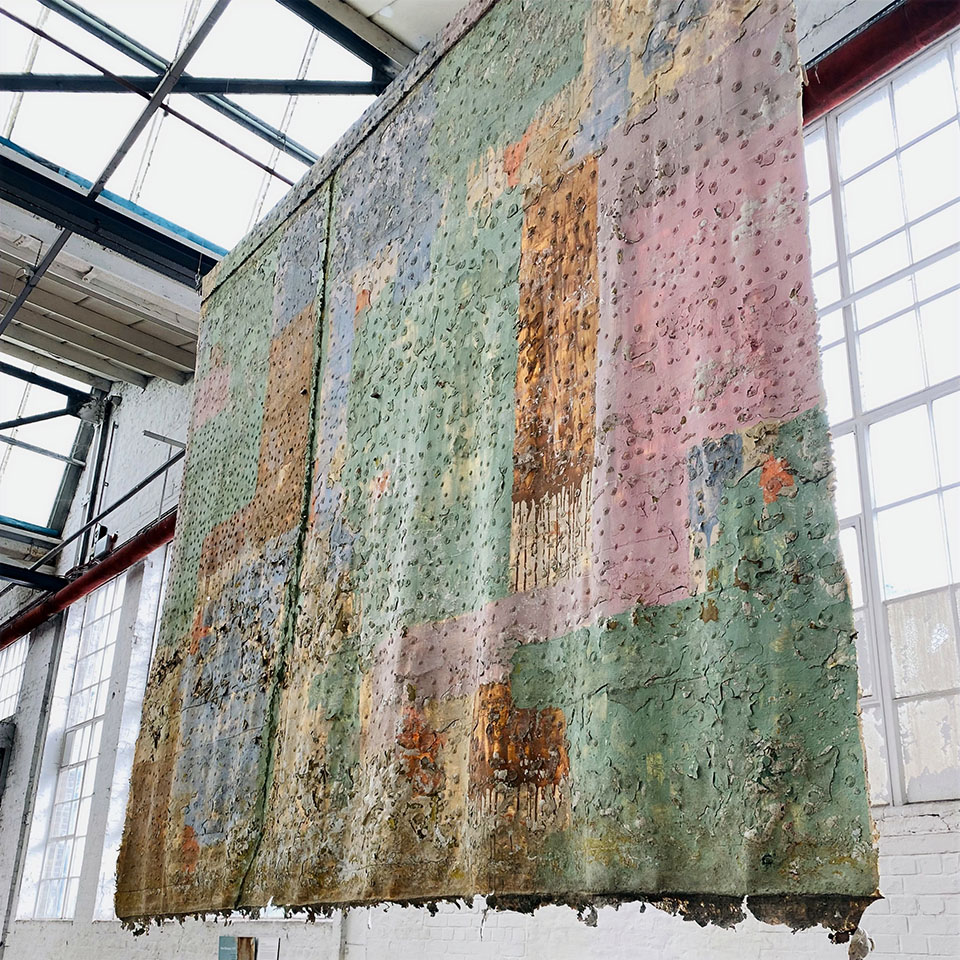
Stef Will
• 23 October 2021
The Factory Project
Yesterday we went to visit an exhibition in London called ‘The Factory Project’. This was an excursion with my MA Fine Art group at UCA. Firstly, it was great to actually get out and into East London. It definitely had been too long.
The exhibition itself, I also really enjoyed. ‘The Factory Project’ is a huge, curated art event (free to visit) during London’s Frieze week. It is based in an old, out-of-use warehouse and yard complex located on the Thameside Industrial Estate (part of the Tate & Lyle sugar factory) in North Woolwich. Conceived by Eric Thorp, Nicholas Stavri and ten curatorial partners, the independent exhibition shows the works of more than 110 emerging and mid-career artists of various backgrounds.
 The massive venue (apparently 67,640 sq ft) is divided up into several multi-disciplinary areas, with some parts being outdoors. The show starts in a large room on the first floor, housing an exhibition called ‘Scratching the Surface’. The room focuses inwards, towards the self and identity, re-inventing self-portraiture, to examine internal dialogues, as well as trying to identify and illuminate the essence of human nature as it were. With various sub-themes including embodied experience, race, feminism and memory, the room invites wide ranging contemplations about self-identification. Leaving this area, the ‘Doors’ project in the courtyard resonated less with me, overall appearing a little ‘rough and ready’ (not helped by the (?unintended) weather-induced degradation of some of the exhibits). Sorry…
The massive venue (apparently 67,640 sq ft) is divided up into several multi-disciplinary areas, with some parts being outdoors. The show starts in a large room on the first floor, housing an exhibition called ‘Scratching the Surface’. The room focuses inwards, towards the self and identity, re-inventing self-portraiture, to examine internal dialogues, as well as trying to identify and illuminate the essence of human nature as it were. With various sub-themes including embodied experience, race, feminism and memory, the room invites wide ranging contemplations about self-identification. Leaving this area, the ‘Doors’ project in the courtyard resonated less with me, overall appearing a little ‘rough and ready’ (not helped by the (?unintended) weather-induced degradation of some of the exhibits). Sorry…
My favourite part however was the last room, a monumental hall divided into multiple, separately curated exhibitions. One of these areas was the ‘Skip Gallery’, created by artists Baker & Borowski, where emerging as well as established artists displayed their interventions in 13 skips dotted around the space. Dismantling and re-inventing a traditionally urban building site like prop, the artworks housed in skips emerged at times surprising, at times ironic, inviting the viewer to challenge expectation and anticipation, never knowing what would present itself when peering into the next skip – be it a gigantic piece of marbled steak, female legs turning like the players in a game of table football, or simply ‘The World As We Know It’.
Moving past the skips, I was drawn to and fascinated by the pre-existing back wall of the warehouse. Witnessing time by exhibiting various degrees of decay and manifold remnants of flaking layers of wall paint, the wall displayed tens of thousands of small round depressions in its surface, scattered all over its entirety. My initial impression was gun fire, but I then learned that these troughs were apparently caused by workers removing tiles from the wall with a tool, maybe a drill? In any case, the wall looked stunningly beautiful with its iatrogenic pattern, and also turned out to be the base for an interesting site-specific work in accreted latex and pigment (‘Freedom of Dissociation’). To create this, artist Andrea Wright took a multi-layer latex impression from the wall’s surface and displayed the resulting cast as an enormous curtain hanging from the ceiling in the ‘Trace Elements | 1971’ area, curated by Rosalind Davis (we were lucky enough to be walked through this area by the curator herself). ‘Freedom of Dissociation’ was definitely one of the highlights for me.
However, arguably my favourite piece was ‘Extrasolar’ by Juliette Mahieux Bartolli in the ‘Recreational Grounds’ exhibition area. A large-scale (more than 5m high!) square assembly of four immersive cyanotypes printed on silk were ghostly floating in the breeze of the cold factory hall. I was interested to find out that the ‘blueprints’ printed on these veils were derived from spacecraft plans, as on first impression they appeared architectural or even map-like to me. In any case, I really enjoyed the tension between the delicacy of the gently moving, semi-transparent fabrics and the hard, metal covered spacecrafts they refer to. And I am still marvelling about the technical details of creating sun-printed cyanotypes of this enormous scale.
Straight after visiting The Factory Project in a gritty East London warehouse, we went on to visit the (rather more polished) Tate Modern a little further West, which felt like quite a culture shock.
Anyhow, in Tate something amazing happened – I turned my deep-seated detestation (I know it’s a strong word, forgive me) for Josef Beuys into love … but more about that in my next blog!
My favourite part however was the last room, a monumental hall divided into multiple, separately curated exhibitions. One of these areas was the ‘Skip Gallery’, created by artists Baker & Borowski, where emerging as well as established artists displayed their interventions in 13 skips dotted around the space. Dismantling and re-inventing a traditionally urban building site like prop, the artworks housed in skips emerged at times surprising, at times ironic, inviting the viewer to challenge expectation and anticipation, never knowing what would present itself when peering into the next skip – be it a gigantic piece of marbled steak, female legs turning like the players in a game of table football, or simply ‘The World As We Know It’.


Moving past the skips, I was drawn to and fascinated by the pre-existing back wall of the warehouse. Witnessing time by exhibiting various degrees of decay and manifold remnants of flaking layers of wall paint, the wall displayed tens of thousands of small round depressions in its surface, scattered all over its entirety. My initial impression was gun fire, but I then learned that these troughs were apparently caused by workers removing tiles from the wall with a tool, maybe a drill? In any case, the wall looked stunningly beautiful with its iatrogenic pattern, and also turned out to be the base for an interesting site-specific work in accreted latex and pigment (‘Freedom of Dissociation’). To create this, artist Andrea Wright took a multi-layer latex impression from the wall’s surface and displayed the resulting cast as an enormous curtain hanging from the ceiling in the ‘Trace Elements | 1971’ area, curated by Rosalind Davis (we were lucky enough to be walked through this area by the curator herself). ‘Freedom of Dissociation’ was definitely one of the highlights for me.
However, arguably my favourite piece was ‘Extrasolar’ by Juliette Mahieux Bartolli in the ‘Recreational Grounds’ exhibition area. A large-scale (more than 5m high!) square assembly of four immersive cyanotypes printed on silk were ghostly floating in the breeze of the cold factory hall. I was interested to find out that the ‘blueprints’ printed on these veils were derived from spacecraft plans, as on first impression they appeared architectural or even map-like to me. In any case, I really enjoyed the tension between the delicacy of the gently moving, semi-transparent fabrics and the hard, metal covered spacecrafts they refer to. And I am still marvelling about the technical details of creating sun-printed cyanotypes of this enormous scale.


Straight after visiting The Factory Project in a gritty East London warehouse, we went on to visit the (rather more polished) Tate Modern a little further West, which felt like quite a culture shock.
Anyhow, in Tate something amazing happened – I turned my deep-seated detestation (I know it’s a strong word, forgive me) for Josef Beuys into love … but more about that in my next blog!








